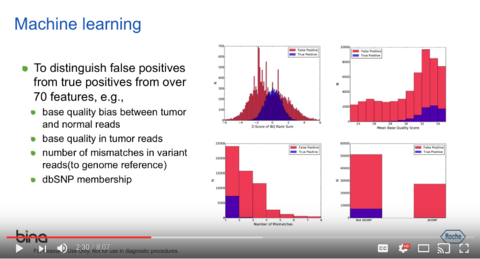bioinform / Somaticseq
Programming Languages
Labels
Projects that are alternatives of or similar to Somaticseq
SomaticSeq
- SomaticSeq is an ensemble caller that has the ability to use machine learning to filter out false positives. The detailed documentation is included in the repo, located in docs/Manual.pdf.
- SomaticSeq's open-access paper: Fang LT, Afshar PT, Chhibber A, et al. An ensemble approach to accurately detect somatic mutations using SomaticSeq. Genome Biol. 2015;16:197.
- Feel free to report issues and/or ask questions at the Issues page.
- The v2 branch is still supported, but it's severely limited comparing to the current versions.
Requirements
This dockerfile reveals the dependencies
- Python 3, plus pysam, numpy, scipy, pandas, and xgboost libraries.
- BEDTools: required when parallel processing is invoked, and/or when any bed files are used as input files.
- At least one of the callers we have incorporated, i.e., MuTect2 (GATK4) / MuTect / Indelocator, VarScan2, JointSNVMix2, SomaticSniper, VarDict, MuSE, LoFreq, Scalpel, Strelka2, TNscope, and/or Platypus. SomaticSeq relies on 3rd-party caller(s) to generate mutation candidates, so you have to run at least one of them, but preferably multiple.
- Optional: dbSNP VCF file (if you want to use dbSNP membership as a feature).
- Optional: R and ada are required for AdaBoost, whereas XGBoost is implemented in python.
- To install SomaticSeq, clone this repo,
cd somaticseq, and then run./setup.py install.
To install from github source with conda
conda create --name my_environment -c bioconda python bedtools
conda activate my_environment
git clone [email protected]:bioinform/somaticseq.git
cd somaticseq
./setup.py install
To install the bioconda version
SomaticSeq can also be found on .
To

conda install -c bioconda somaticseq.
Test your installation
There are some toy data sets and test scripts in example that should finish in <1 minute if installed properly.
Run SomaticSeq with an example command
-
At minimum, given the results of the individual mutation caller(s), SomaticSeq will extract sequencing features for the combined call set. Required inputs are
--output-directory,--genome-reference,paired|single,--tumor-bam-file, and--normal-bam-file. Everything else is optional (though without a single VCF file from at least one caller, SomaticSeq will have nothing to do). -
The following four files will be created into the output directory:
-
Consensus.sSNV.vcf,Consensus.sINDEL.vcf,Ensemble.sSNV.tsv, andEnsemble.sINDEL.tsv.
-
-
If you're searching for pipelines to run those individual somatic mutation callers, feel free to take advantage of our Dockerized Somatic Mutation Workflow.
# Merge caller results and extract SomaticSeq features
somaticseq_parallel.py \
--output-directory $OUTPUT_DIR \
--genome-reference GRCh38.fa \
--inclusion-region genome.bed \
--exclusion-region blacklist.bed \
--algorithm xgboost \
--threads 24 \
paired \
--tumor-bam-file tumor.bam \
--normal-bam-file matched_normal.bam \
--mutect2-vcf MuTect2/variants.vcf \
--varscan-snv VarScan2/variants.snp.vcf \
--varscan-indel VarScan2/variants.indel.vcf \
--jsm-vcf JointSNVMix2/variants.snp.vcf \
--somaticsniper-vcf SomaticSniper/variants.snp.vcf \
--vardict-vcf VarDict/variants.vcf \
--muse-vcf MuSE/variants.snp.vcf \
--lofreq-snv LoFreq/variants.snp.vcf \
--lofreq-indel LoFreq/variants.indel.vcf \
--scalpel-vcf Scalpel/variants.indel.vcf \
--strelka-snv Strelka/variants.snv.vcf \
--strelka-indel Strelka/variants.indel.vcf
-
--inclusion-regionor--exclusion-regionwill require BEDTools in your path. -
--algorithmwill default toxgboostas v3.6.0, but can also beada(AdaBoost in R). XGBoost supports multi-threading and can be orders of magnitude faster than AdaBoost, and seems to be about the same in terms of accuracy, so we changed the default fromadatoxgboostas v3.6.0. - To split the job into multiple threads, place
--threads Xbefore thepairedoption to indicate X threads. It simply creates multiple BED file (each consisting of 1/X of total base pairs) for SomaticSeq to run on each of those sub-BED files in parallel. It then merges the results. This requiresbedtoolsin your path. - For all input VCF files, either .vcf or .vcf.gz are acceptable.
Additional parameters to be specified before paired option to invoke training mode. In addition to the four files specified above, two classifiers (SNV and indel) will be created..
-
--somaticseq-train: FLAG to invoke training mode with no argument, which also requires ground truth VCF files as follows: -
--truth-snv: if you have a ground truth VCF file for SNV -
--truth-indel: if you have a ground truth VCF file for INDEL
Additional input files to be specified before paired option invoke prediction mode (to use classifiers to score variants). Four additional files will be created, i.e., SSeq.Classified.sSNV.vcf, SSeq.Classified.sSNV.tsv, SSeq.Classified.sINDEL.vcf, and SSeq.Classified.sINDEL.tsv.
-
--classifier-snv: classifier previously built for SNV -
--classifier-indel: classifier previously built for INDEL
Without those paramters above to invoking training or prediction mode, SomaticSeq will default to majority-vote consensus mode.
Do not worry if Python throws the following warning. This occurs when SciPy attempts a statistical test with empty data, e.g., z-scores between reference- and variant-supporting reads will be NaN if there is no reference read at a position.
RuntimeWarning: invalid value encountered in double_scalars
z = (s - expected) / np.sqrt(n1*n2*(n1+n2+1)/12.0)
Run SomaticSeq modules seperately
Most SomaticSeq modules can be run on their own. They may be useful in debugging context, or be run for your own purposes. See this page for your options.
Dockerized workflows and pipelines
To run somatic mutation callers and then SomaticSeq
We have created a module (i.e., makeSomaticScripts.py) that can run all the dockerized somatic mutation callers and then SomaticSeq, described at somaticseq/utilities/dockered_pipelines. There is also an alignment workflow described there.
You need docker to run these workflows. Singularity is also supported, but is not optimized.
To create training data to create SomaticSeq classifiers
We have also dockerized pipelines for in silico mutation spike in at somaticseq/utilities/dockered_pipelines/bamSimulator. These pipelines are based on BAMSurgeon. We have used it to create training set to build SomaticSeq classifiers, though it has not been updated for a while.
GATK's best practices for alignment
Described at somaticseq/utilities/dockered_pipelines. The module is makeAlignmentScripts.py.
Additional workflows
- A Snakemake workflow to run the somatic mutation callers and SomaticSeq was created by Afif Elghraoui at somaticseq/utilities/snakemake. It needs to be updated to work.
Video tutorial
This 8-minute video was created for SomaticSeq v1.0. The details are slightly outdated, but the main points remain the same.

